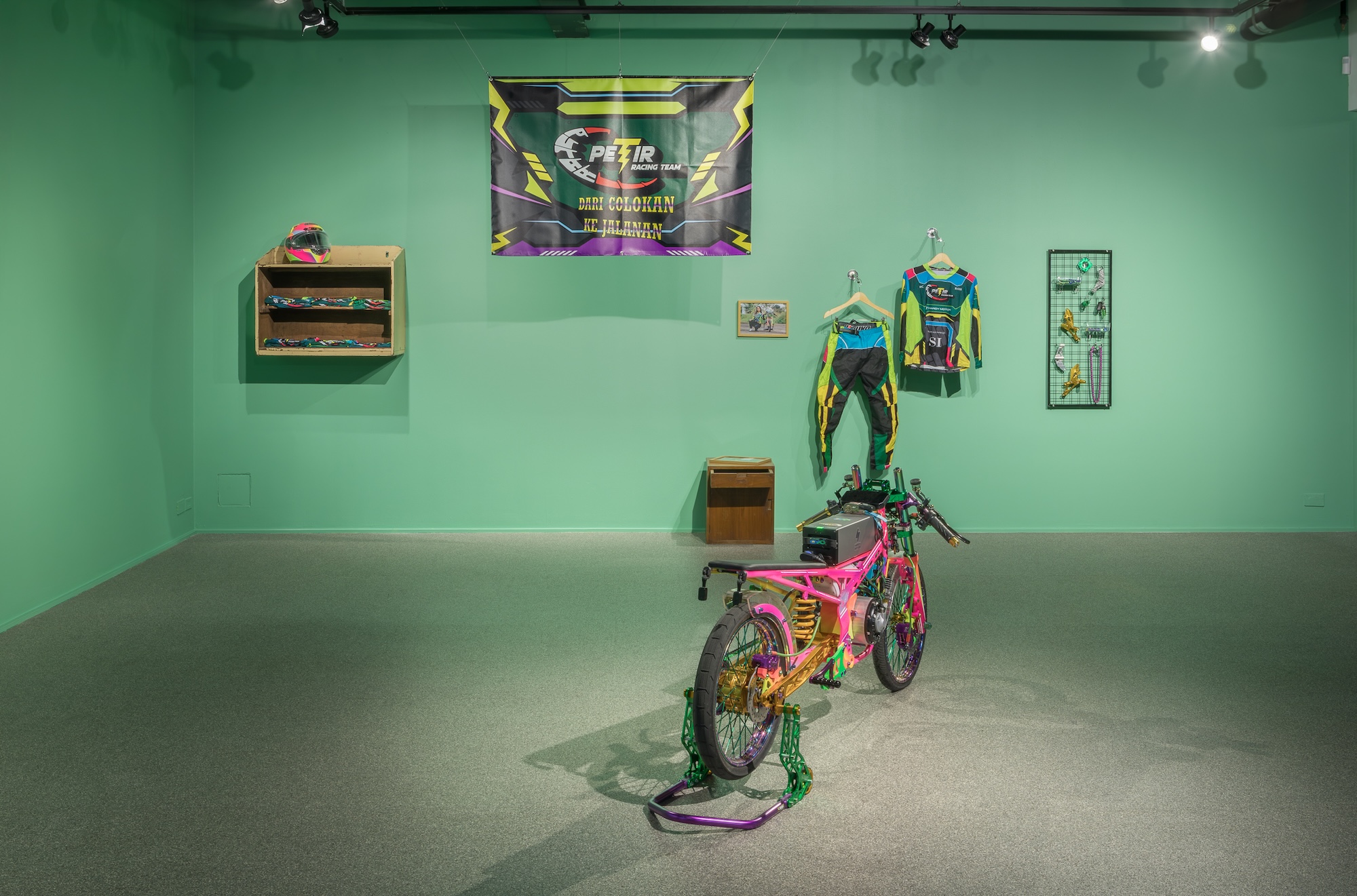The artist’s first institutional presentation outside of Asia, at New York’s Swiss Institute, tells a story of industry, spirituality and postcolonial culture in spare parts
The walls are seafoam green in one of the galleries of Bagus Pandega’s solo exhibition. Parked in the centre of the room is a custom drag-racing bike that Pandega, known as a tinkerer with a penchant for working-class aesthetics, built for the show using spare parts and an electric battery. This, the Indonesian artist’s first institutional presentation outside of Asia, was organised by Swiss Institute in collaboration with Kunsthalle Basel, where a corresponding exhibition, Sumber Alam, is concurrently on view. The shows’ titles work in tandem, playfully recombining four Indonesian words: daya (‘power’), alam (‘natural’), sumber (‘source’) and benda (‘object’). However, since most viewers will have to take their pick of travel destinations, the two shows can be treated separately. At Swiss Institute, three sculptural installations occupy two floors and the roof. The green gallery, on the second floor, contains Pandega’s newly commissioned installation Putar Petir Racing Team (2025), which transforms the space into something of a curiously furnished storefront.
Along the walls, one finds a spare selection of readymade and custom-fabricated artwork resembling merchandise (and described as ‘custom merchandise’ in the checklist). A nightstand sits with its drawer open, filled with bumper stickers bearing the logo of the fictitious racing crew. Stylised in all caps, ‘PUTAR’ (meaning ‘turn’ in English) is warped into a partial ellipse; the ‘T’ in ‘PETIR’ (‘lightning’) is a yellow lightning bolt. The logo appears on a vinyl banner hanging from the ceiling, on about a dozen custom-designed racing jerseys that line a paint-chipped shelf and on the bikers modelling them in photographs encased in quaint wooden frames. An acrylic keychain that reads ‘Swiss Institute’ hangs on a gridwall panel next to a smattering of aftermarket motorbike parts and accessories spraypainted gold, green and purple. On two monitors, montages of footage including adrenalising shots of Pandega’s motorbike competing in a race in Indonesia and TikTok videos in which users show off their own bikes loop to an upbeat electronic soundtrack that plays into the gallery. In relation, the contents of the installation feel far-removed from the action. The motorbike on the floor seems reduced to a decorative prop used to sell team jerseys.

Putar Petir Racing Team appears, at least on the surface, worlds apart from Pandega’s older installation Hyperpnea Green (2024) in the main gallery downstairs, which viewers encounter first. Arranged around a room-spanning ring of galvanised pipe suspended from the ceiling are about three dozen mineral specimens, which vary in colour – from that of dirt to lard to jade – and look as if they are pickling in liquid-filled jars. These jars are hooked up to a superhighway of tubing that, according to the press release, senses viewers’ exhalations and responds by pumping oxygen into the room. Atop the apparatus, a potted tree sits under a magenta heat lamp, looking deified against its will. The conceptual gap between this and Putar Petir Racing Team is bridged by Pandega’s third work, Anim Wraksa (2025), a nickel-encrusted twig submerged in a green electrolyte solution on the first floor, whose image is broadcast on an LED board on the roof.
Anim Wraksa draws viewers’ attention to nickel, a key component in many electric vehicle batteries. Since mining for the metal began in Indonesia during the early twentieth century and accelerated during the 1960s, the industry has damaged local soil, forests and water systems, as well as, the exhibition materials remind us, ‘social and spiritual relations’ in the postcolonial country. Given that nickel extraction enables Pandega to power and race his homemade motorbike and that the juxtaposition of works in Daya Benda – whose title translates in English to ‘Power of Objects’ – emphasises rather than elides this quirk in his design, viewers are prompted to consider the bike not as a finished product, like a keychain or banner, but as a workable prototype. The exhibition, by extension, presents itself as a shrine to experimentation, disassembly and recombination, albeit one that requires sifting through vibrant merchandise and spectacular machinery to access.
Daya Benda at Swiss Institute, New York, through 4 January
Read next An art-history of lowriders
